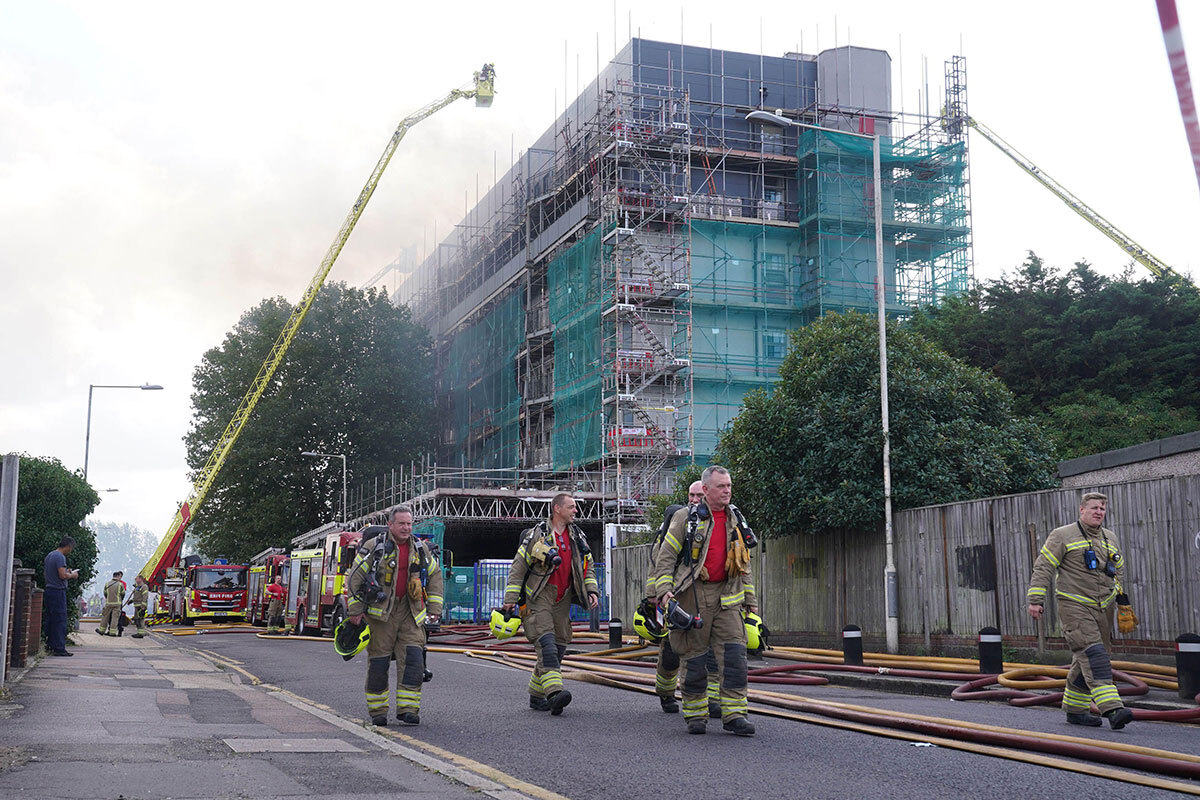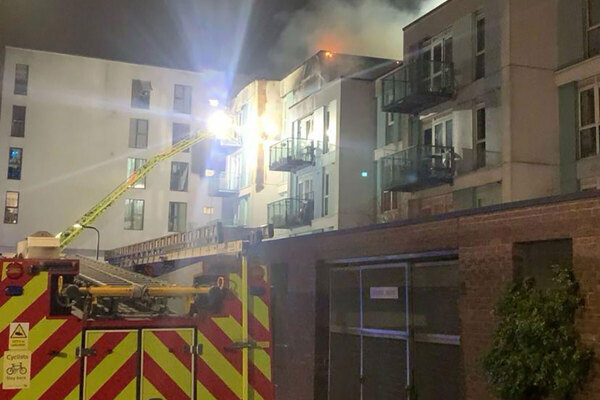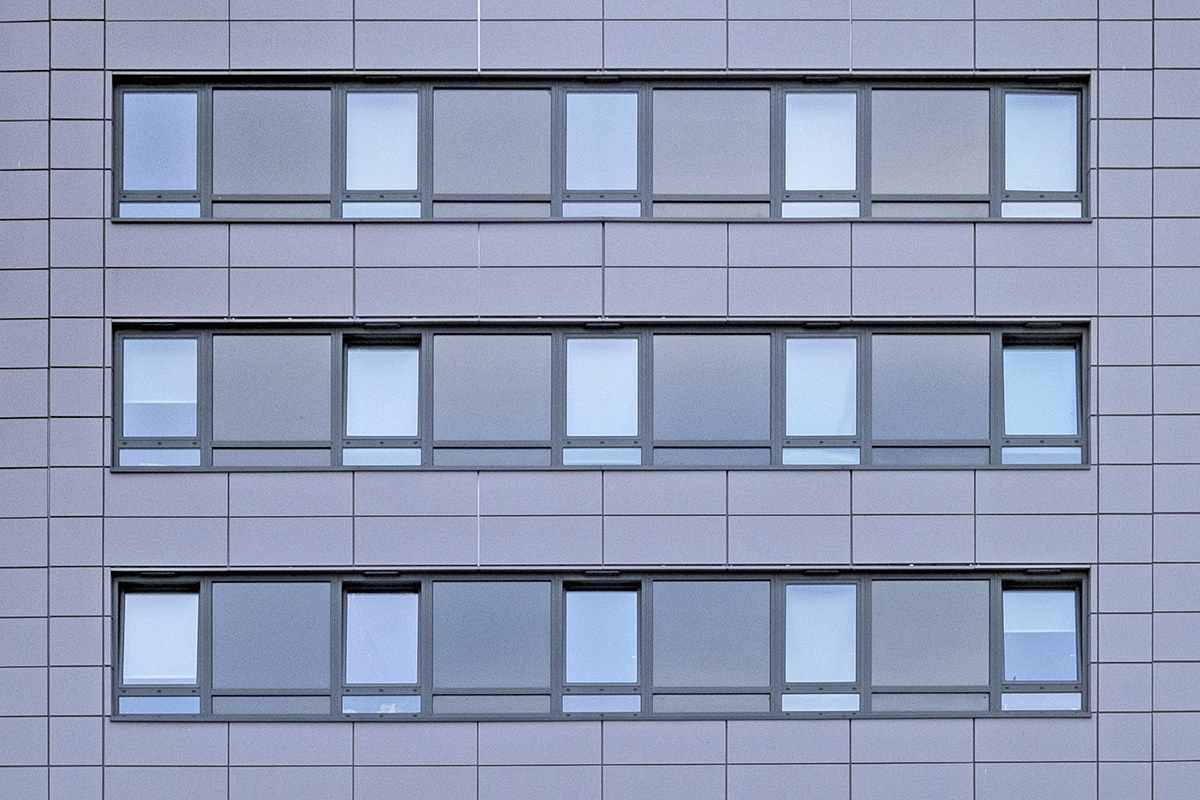Dagenham fire: what happened and what we know about the building
A fire at a block of flats in Dagenham, east London, on Monday has sparked fresh debate about the slow progress of cladding remediation in the UK. James Riding runs through what we know so far
More details are emerging about the fire that engulfed the Spectrum Building on Freshwater Road overnight on 26 August. We now know that the block had several fire safety issues and cladding remediation work was underway when the fire broke out.
It also appears that residents had highlighted their fears about wooden decking on balconies and “broken” fire doors as far back as 2018.
How the fire unfolded
Forty fire engines and 225 firefighters tackled the blaze at the Spectrum Building. The whole block was affected by the fire, including scaffolding that had been surrounding the property and roof.
The fire brigade was called at 2:44am and the first crew arrived within five minutes. The fire, which was declared a major incident, was under control by 11.13am.
Everyone has been accounted for, with more than 80 people evacuated. Four people were treated on scene by ambulance crews and two people were taken to hospital.
London fire commissioner Andy Roe said the building has “a number of fire safety issues known to London Fire Brigade”. He added: “We will now begin a full investigation into the fire and its cause.
“This was a very dynamic and challenging incident, and we know there will undoubtedly be concerns around the fire safety issues present within the building and this will form part of our report.”
What we know about the building
According to the Spectrum Building’s registration data with the Building Safety Regulator, the block is seven storeys above ground with a basement and 19.7m tall.
The i reported that the block of flats is an office-to-residential conversion. The property was originally the office of the American chemical company DuPont. The building was built in 1974 and converted to flats in the 2010s, with solar panels and a roof deck area added.
In 2017, planning permission was sought to add more flats on top of the block, with the new storeys supported by a timber frame. The application was refused, but then granted in 2018 following an appeal. The building now consists of 60 flats, as well as a communal roof terrace, two commercial units and a gym.
The developer of the building was Chadwell Properties and the current freeholder, Arinium, took over ownership of the block in January 2020.
The developer was warned about fire safety in the building.
According to The Times, emails filed by residents alongside the planning application to increase the number of flats showed they had raised concerns about fire safety with the block management company.
In February 2022, the Spectrum Building’s residents’ association submitted written evidence to parliament as part of the post-Grenfell safety legislation process. According to this evidence, roughly one-third of the flats in the block are owned by live-in leaseholders, with the rest occupied on a buy-to-let basis.
In its evidence to parliament, the residents’ association referenced a September 2020 external wall survey, which found the block did not fully meet building regulations at the time of construction.
The residents’ association warned that the “stress on leaseholders living in unsafe, unsellable flats with increasing service charges for well over three years is considerable”.
In April 2023, the London Fire Brigade issued an enforcement notice to Block Management UK, the management company for the building, urging it to review its fire risk assessment and emergency plan and implement preventative measures.
When the fire broke out, remediation work was underway to remove “non-compliant” cladding from the block, with scaffolding covering parts of the building.
Planning permission was granted in May 2023 for the removal of cladding on the fifth and sixth floors and its replacement with compliant cladding, as well as the removal of window spandrel panels and balcony privacy screens.
The work had been due to begin in June 2023 and finish in December, but last week cladding manufacturer Valcan wrote on Facebook that work to replace the cladding was ongoing.
What was the cladding and how was it being remediated?
Planning documents from April 2023 show how the cladding removal was designed to work. Non-compliant high pressure laminate Trespa cladding panels would be removed and replaced with new Valcan "Cerama" cladding panels, attached to the existing internal build-up.
Also, non-compliant spandrel panels would be removed and replaced with new Mettaline "Ultima" PPC aluminium-clad compliant panels.
Reaction
The Grenfell United group of survivors and bereaved families said that the Dagenham fire was “a scenario we have warned about for seven years”.
It continued: “Although we do not have all the details, it seems work was underway to remove non-compliant cladding and the building had a number of fire safety issues.
“This highlights the painfully slow progress of remediation across the country and a lack of urgency for building safety as a whole, including the implementation of personal evacuation plans for disabled residents which needs urgently addressing.”
Adding that the Grenfell Inquiry Phase Two report is due in a week’s time, Grenfell United said “the fact that when a fire happens and the best we can hope for at the moment is ‘a near miss’, speaks volumes of the progress made since 14 June 2017”.
Deputy prime minister and housing secretary Angela Rayner said: “Our thoughts are with all those affected by the fire in Dagenham at this very difficult time.
“We are in close contact with the London Fire Brigade, council and other agencies on the ground to ensure those affected are being looked after.”
Margaret Mullane, Labour MP for Dagenham and Rainham, called for an investigation into why flammable cladding on the eight-storey building had taken so long to be removed.
She said: “We are seven years on from Grenfell and there is no reasonable excuse for unsafe cladding on residential blocks. Thankfully there was no loss of life, but 80 households have been displaced and serious questions must now be asked.”
Matt Wrack, general secretary at the Fire Brigades Union, said the blaze exposed the “national scandal of flammable cladding and deregulation in the building industry”. He said warnings about building safety had been “ignored by public authorities and by central government”.
The End Our Cladding Scandal campaign group said: “Being ‘in negotiations’ about remediation or having ‘plans in place’ counts for little when dangerous cladding – or other construction defects that enable fire to spread rapidly – remain on people’s homes.
“Today’s [Monday’s] incident demonstrates why action remains so urgent. Fire won’t wait while the legal and administrative battle rumbles on for years at each individual building.”
Key questions
The fire is a big test for the one-year-old Building Safety Regulator (BSR). “Since the BSR got their powers, there hasn’t been a major fire in a high-rise block,” says Matt Hodges-Long, chief executive of TrackMyRisks. “This is the canary in the coal mine. What do they do? Do they investigate, do they prosecute?”
He says the fire could prompt a debate about whether residents should be decanted from buildings while cladding remediation takes place. “Obviously it would cause a massive increase in cost, but can these remediations be done in a safe manner?”, he asks.
Other questions that must be asked in the coming days include:
-
How much of the non-compliant Trespa cladding had been removed at the time of the fire?
-
What was the status of the 2023 enforcement notice from the London Fire Brigade? To what extent had it been complied with?
-
Did the London Fire Brigade know about any faulty fire equipment in the building before the fire
Update
In a statement on Thursday, the Health and Safety Executive (HSE) - the Building Safety Regulator - said it is continuing to make enquiries into the fire.
It said: “We remain in contact with first responders and we are working closely with colleagues in the London Fire Brigade on the way forward with our respective investigations, this engagement will be ongoing.”
The regulator said inspectors from its investigations and building safety divisions attended the site on Thursday.
It is understood that a joint investigation team within the HSE will work closely with the LFB, the police and other parties including the council.
Areas the regulator is investigating include how the cladding remediation works were organised and undertaken, and whether this was a factor in the fire.
A probe would also look into whether the principal accountable person for the building had discharged their duties under Part 4 of the Building Safety Act in relation to spread of fire.
Sign up for our fire safety newsletter
Already have an account? Click here to manage your newsletters












